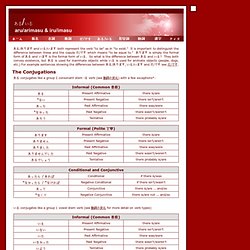

Type I, Type II and Type III Verbs. Before we even start to learn verbs, it is important for me to point out that these rules for learning verbs and the changing of forms usually only applies to foreigners or 外人 (gaijin).

My 先生 (sensei) once told me, these rules are created to have those who are not native to the language learn faster and remember them better. Hence, if you are learning Japanese using these rules, please take note that the kids from Japan may not learn it the same way as you. Matsukaze Nihongo Annai - aru/arimasu & iru/imasu. ある/あります and いる/います both represent the verb "to be" as in "to exist.

" It is important to distinguish the difference between these and the copula だ/です which means "to be equal to. " あります is simply the formal form of ある and います is the formal form of いる. So what is the difference between ある and いる? They both convey existence, but ある is used for inanimate objects while いる is used for animate objects (people, dogs, etc.)
Textbook. Practice. Asian Media.